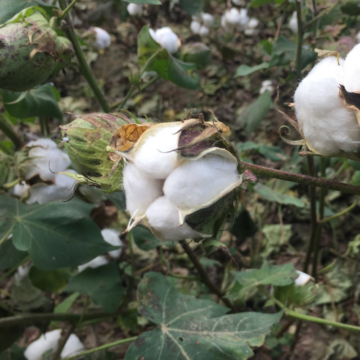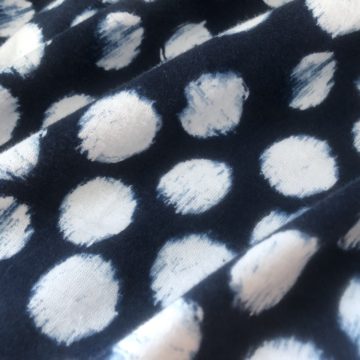Although most people think of cotton in it’s final mature state, it’s important to remember that cotton has to grow from seed throughout the season to get to that point. And it’s amazing how often I’ve had folks ask me about something they’ve seen in a field as they were driving by, like this recent tweet from Sam Wildman:
@JPlovesCOTTON so I'm driving though Georgia today wondering if its cotton season & what a cotton field (cont) http://tl.gd/9fngdm
— Sam Wildman (@TheSamWildman) March 25, 2011
So, I thought I’d put together some photos here, that will help me reply to hopefully lots of interest in southern fields! So let’s look at cotton plants and fields different times of year.
Planting Cotton (US typically begins mid-March & goes through May)

Cotton seed for planting is sold in both bags of 40-60 pounds — since seed size varies, the bag weights vary by variety. And its also sold in bulk boxes which farmers say provides them a way to get planters filled more quickly & efficiently to keep tractors moving. As I mentioned in a post on planting considerations, some farmers plant on beds and others plant on flat ground. Similarly some use small planters and others use enormous planters on the back of the tractor.
Early-Season Cotton
Cotton always looks so vulnerable to me when its a seedling. The plants move much like sunflowers in those earliest days as cotton loves sun and heat (sort of like me that way!) The plants are usually dropped with a few inches of space between though some are dropped in twos or threes depending on the planting equipment which makes the plants seem even more spread out early on. Whereas corn and soybeans can appear to be at a 90 degree angle to the soil, cotton’s leaves look more parallel with the soil.
Mid-Season Cotton
The plants bush up with fruiting and reproductive branches quickly assuming there is good heat and sunshine. The leaves of most upland varieties are broad and remain largely parallel to the soil to provide a lot of photosythetic energy. When I’m driving along a highway, reminding myself about the different leaf shape and angle is what distinguished the two crops for me as many soybeans are planted on similar row patterns in the south and one you near canopy it can be hard to see the difference in planting population.
Cotton During Fruiting

I think cotton blooms are beautiful and my friend, California farmer Cannon Michael thinks Pima flowers are so pretty, they were the first flowers he gave a girlfriend who later became his wife. The plant produces blooms that are a creamy yellow bud that will open mid-day and self-pollinate (meaning no bees, wind, etc is needed) that afternoon. By the following mornings, the pinkish hue begins to develop and the bloom changes color indicating pollination has occurred. The bloom dries up and a small bloom forming at the bloom’s base pushes the dry petals off the plant. That boll gets really hard and grows using a lot of the energy photosynthesis provides.
Harvest Time Plants and Fields (US typically begins in September & goes through December)
As days begin to shorten and heat units are reduced, the amount of energy in the cotton plant also goes down. Leaves begin to change color and drop off and bolls begin to crack and continue opening to show the mature fiber insider. That’s when the fun of harvest gets started!
After Cotton Harvest, There’s Still Work to Do
 Cotton harvest equipment leaves the crop in the field til module trucks come to transport the seed cotton to the gin for processing. Farmers also want to cut all the stalks down near the ground & shred them to minimize over-wintering by insect pests. For many areas that prefer to plant on a raised bed, farmers will do this field work in the fall, allowing the soil to store moisture and “mellow” over the rainy season. In some areas, farmers may plant a winter crop of wheat which may be harvested before another crop is put in the ground.
Cotton harvest equipment leaves the crop in the field til module trucks come to transport the seed cotton to the gin for processing. Farmers also want to cut all the stalks down near the ground & shred them to minimize over-wintering by insect pests. For many areas that prefer to plant on a raised bed, farmers will do this field work in the fall, allowing the soil to store moisture and “mellow” over the rainy season. In some areas, farmers may plant a winter crop of wheat which may be harvested before another crop is put in the ground.
Hope that helps you get the picture!
Pulling the photos together from a few years of living in the Cotton Belt was a lot of fun and I hope it helps you get a picture of what our rural roadsides look like through the year. I’m sure some of the descriptions were brief and I may have left questions. Would be glad to use your ideas for future Cotton 101 posts as I plan to build the series over the coming season. Ask whatever comes to mind in the comments and I’ll see what I can do on answers! There are a few Cotton 101 posts on this page and you should feel free to check out the latest posts with the Cotton 101 tag too and hear from people who love cotton (either as a farm or fiber product) check out the Cotton Guest post category!








This is a very informative article. People who aren’t familiar with farm life and cotton harvesting have little idea of how much time and patience go into cultivating this natural fiber product. Cotton is a staple of American commerce, clothes, soaps, and paper towels are made from this plant. After reading this article I have an appreciation for the work involved and the role that cotton farmers who help to power our economy.
Thanks for coming by. Something as simple as a tshirt and jeans and yet very few people think about the fact it came from a farm somewhere. I think that’s awesome to realize now and then!
We appreciate the Cotton farmers, as we feed whole cotton seeds – a byproduct of the ginning process – to our cattle as a source of protein. An added bonus is a playground for our boys at the dairy!! 🙂
LOL! I’ve played in a pile or two of fuzzy cotton seed too…. lots of fun!
Nothing is more beautiful than a white field of cotton!!! NOTHING
I AGREE! It is a beautiful crop!
Having grown up in the 50’s and 60’s chopping and picking cotton I did not consider it beautiful at all.
Thank you for this site…I planted some cotton balls (with the seeds inside) in a planter after returning home from Arizona for the winter..I picked some up that were at the edge of an already picked field of cotton there…..and they are growing nicely…we have had some hot weather here in Iowa this summer and I am sure they are loving it. I was surprised to see the flowers…didn’t have a clue that they flowered and was wondering about what would come next and this is the only site that I found the answers..thank you..My daughter calls this my “Plantation in a Bucket”…
I LOVE IT! Thanks for letting me know Linda as I frequently wonder if this is helpful to others or not! Feel free to let me know what questions you have – Love reasons to blog. And you should send me a few photos of your plantation in a bucket! That sounds like something I should add to the blog! My email is jplovescotton at janiceperson dot com.
How did you start the seed. I just stopped in a Georgia field and picked huge pile of cotton do I plant the seeds with some cotton on them? [email protected]. Thanks for your help
Thank you Janice for your cool blog about how cotton grows. I am a sewing instructor and I am giving a lecture on Natural fibers. I thought it would be fun to grow some cotton plants in class! I live on California. Can I grow cotton in my garden or in pots?
Judy Bowerman
Great question! Maybe I should work through this and make the process into another blog post! I’ll send you an email with some info we’ll need to figure it out. – jp
Thanks for the 101 cotton. We are winter heat seekers from Canada. Have spent my life as a cereal and pulse producer Mid West Canada and have a passion for AG. We are spending a few weeks in Arizona and enjoying another aspect of production along with the heat. Produce and Cotton very interesting to me.
Thanks for stopping by! Nice to meet you. I have to say, I have a lot to learn about growing cereals & pulses — I know a good bit about eating them though ;). Hope you have a great winter — I am totally ready for spring!
Back when cotton was picked by hand, what part of the plant was sharp and could cause cuts on field workers’ hands? Was it the outer covering of the boll, or some other part?
The part that covers the boll when it is green dries down to what is called the bracts and it helps keep the cotton on the plant until it is picked. It is really tough and sharp! I have cut my hands on them and can’t imagine having to pick like folks did before mechanical pickers. I think this video where you see a cracked boll and open one may help you understand better. https://janiceperson.com/cotton/cotton-101-understanding-cotton-plant-video/
I am thinkin a cotton plantation in a bucket is my style…recently saw a vase w/ beautiful cotton buds (bolls). So perfect for “staging” homes for sale, bring the outside in, that’s my passion! However I live in NJ…cold til May. Do I dare try in spring or can you guide me to purchase few seeds or where can I find “real to fake” bolls on stems as I have a blue vase just waiting… I loved reading your blog…lived long enough to remember the BOLL WIEVEL SONG (sp) Thankin you in advance, georgie
Awesome article! Thank you!!
Glad you enjoyed it!
Thanks for all those pictures about cotton, it takes me back to the day, where my family had to travel hundreds of miles to pick cotton. In order to put food in our table, this was done for over twenty years, I give thanks to the cotton fields it was our only hope to back, a stepping stone to a better life. Thank again. Martiniano Chapa
I appreciate all the farmers way back in the day that picked cotton by force. If it wasn’t for them, we wouldn’t have much of what we have today. It started way back in slavery days. I thank God for them men and women who started this for Us. Give thanks to the true cotton pickers.
Hi, I moved into a new home in south Florida and I had a small 2′ plant in my front yard that produced pretty flowers resembling a hybrid hibiscus but the leaves were not of a tropical hibiscus at all. As it grew, to my amazement it was producing cotton boles. It is beautiful, grows rather quickly and is a great conversation piece in my yard for visitors. It has produced much cotton on it and has reached about 8′ to 9′ high and I need to know when to cut it back and how to cut it? I would like to transplant it to another location if possible. Any direction in this would be greatly appreciated. Thank you for your blog. 🙂
DB